Motivation in Workplace: Theories and Strategies for Managers
VerifiedAdded on 2023/06/11
|12
|3492
|297
AI Summary
This report discusses the importance of motivation in the workplace and how managers can enhance employee motivation. It covers various theories of work motivation, including the John Holland theory of personality and job fit, and the difference between content and process theories. The report also provides strategies for managers to motivate employees. Course code, course name, and college/university are not mentioned.
Contribute Materials
Your contribution can guide someone’s learning journey. Share your
documents today.
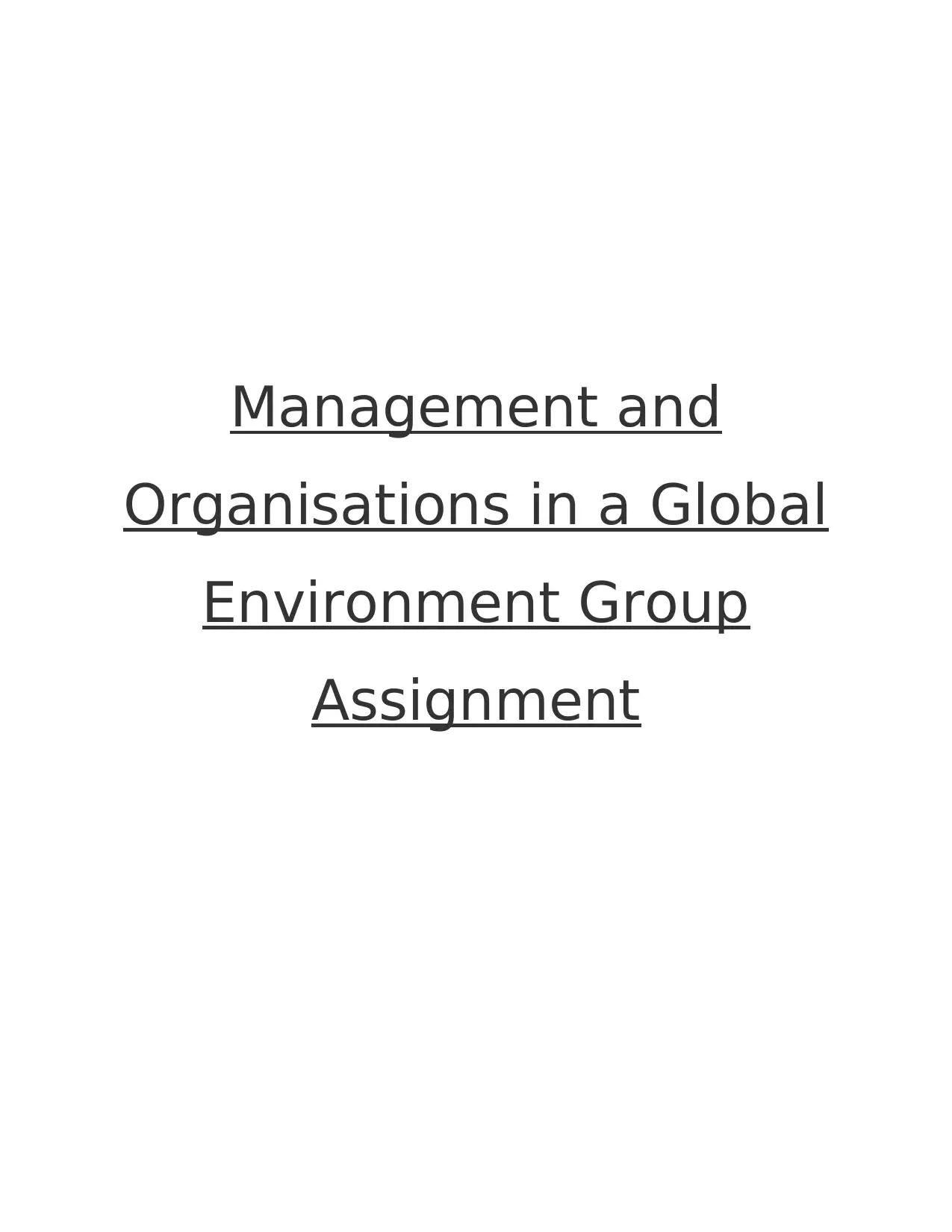
Management and
Organisations in a Global
Environment Group
Assignment
Organisations in a Global
Environment Group
Assignment
Secure Best Marks with AI Grader
Need help grading? Try our AI Grader for instant feedback on your assignments.
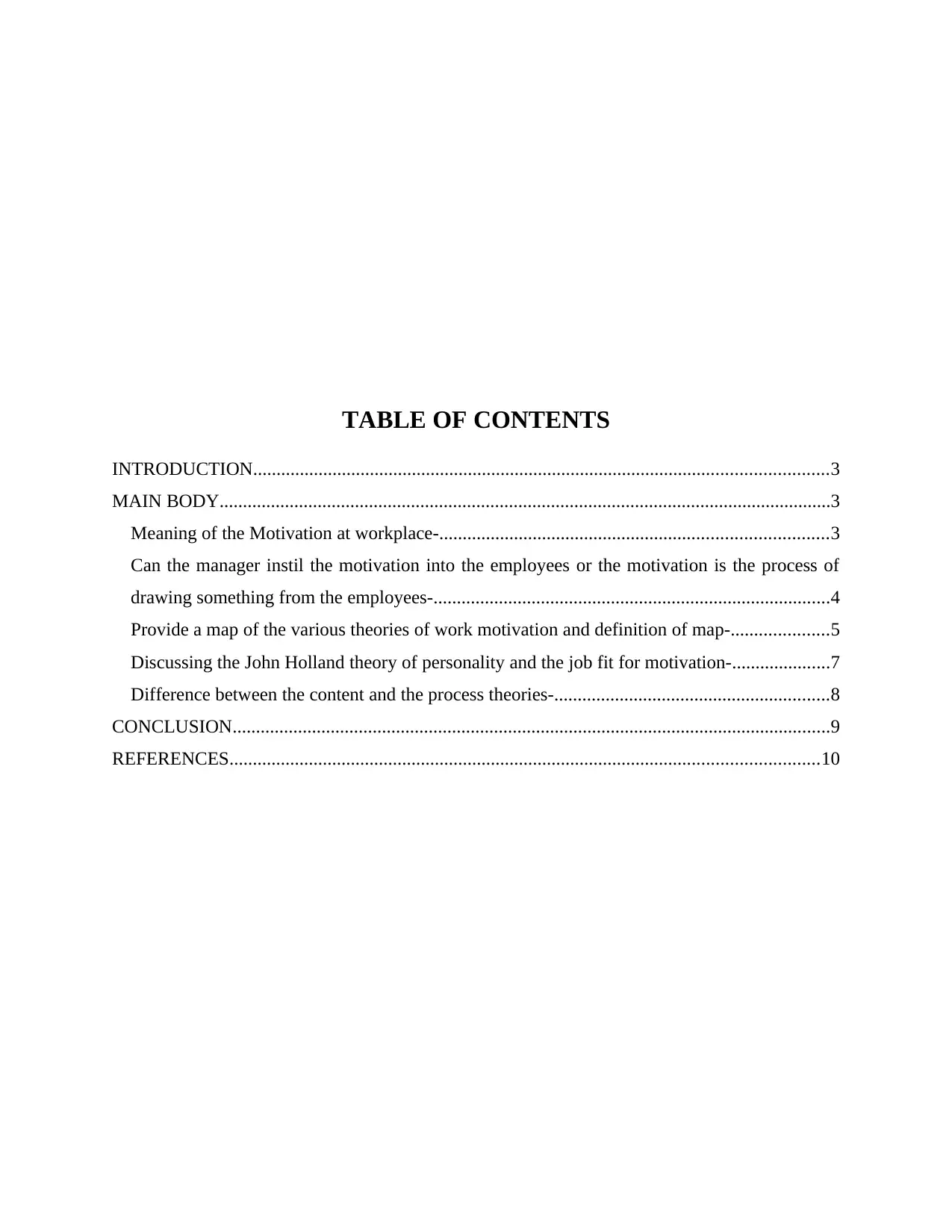
TABLE OF CONTENTS
INTRODUCTION...........................................................................................................................3
MAIN BODY...................................................................................................................................3
Meaning of the Motivation at workplace-...................................................................................3
Can the manager instil the motivation into the employees or the motivation is the process of
drawing something from the employees-.....................................................................................4
Provide a map of the various theories of work motivation and definition of map-.....................5
Discussing the John Holland theory of personality and the job fit for motivation-.....................7
Difference between the content and the process theories-...........................................................8
CONCLUSION................................................................................................................................9
REFERENCES..............................................................................................................................10
INTRODUCTION...........................................................................................................................3
MAIN BODY...................................................................................................................................3
Meaning of the Motivation at workplace-...................................................................................3
Can the manager instil the motivation into the employees or the motivation is the process of
drawing something from the employees-.....................................................................................4
Provide a map of the various theories of work motivation and definition of map-.....................5
Discussing the John Holland theory of personality and the job fit for motivation-.....................7
Difference between the content and the process theories-...........................................................8
CONCLUSION................................................................................................................................9
REFERENCES..............................................................................................................................10
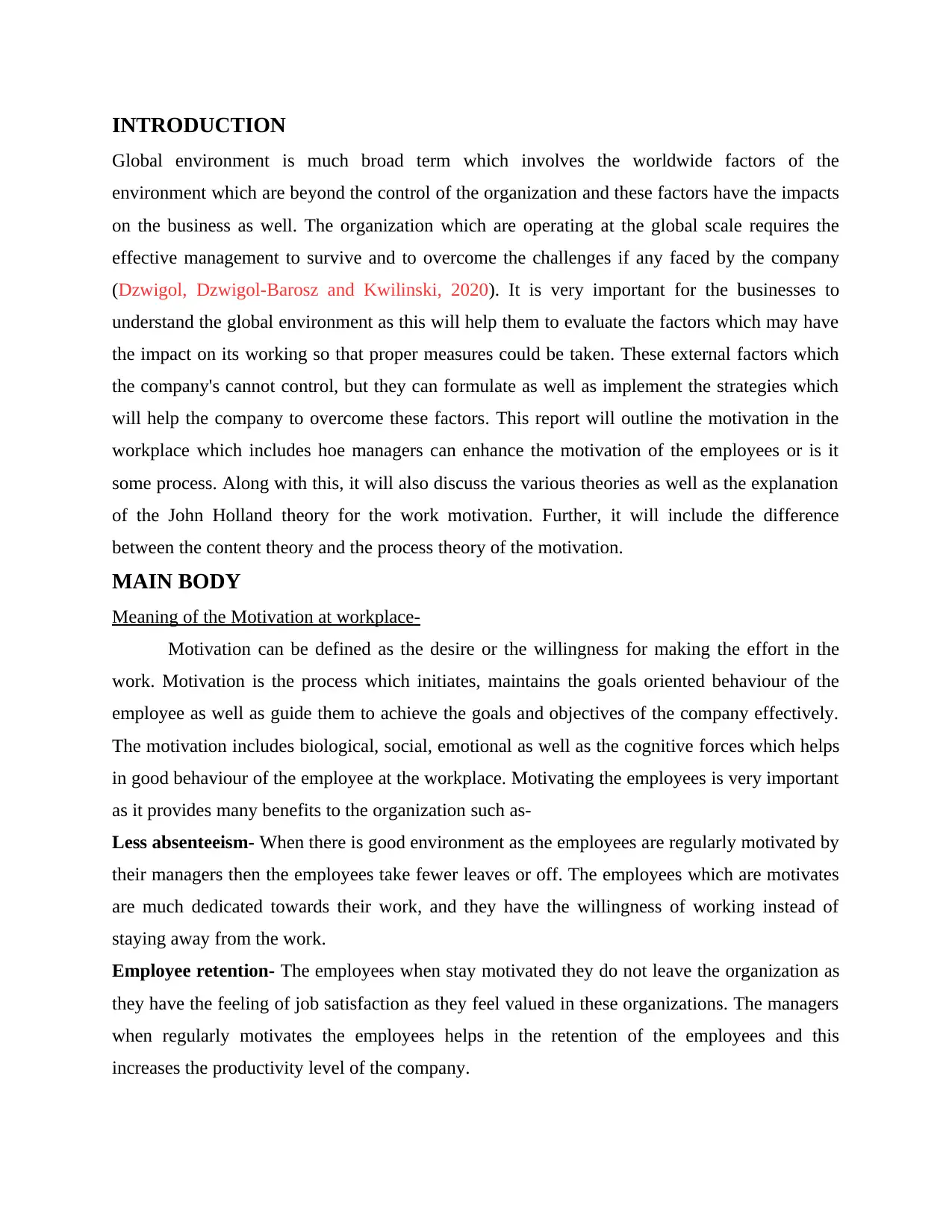
INTRODUCTION
Global environment is much broad term which involves the worldwide factors of the
environment which are beyond the control of the organization and these factors have the impacts
on the business as well. The organization which are operating at the global scale requires the
effective management to survive and to overcome the challenges if any faced by the company
(Dzwigol, Dzwigol-Barosz and Kwilinski, 2020). It is very important for the businesses to
understand the global environment as this will help them to evaluate the factors which may have
the impact on its working so that proper measures could be taken. These external factors which
the company's cannot control, but they can formulate as well as implement the strategies which
will help the company to overcome these factors. This report will outline the motivation in the
workplace which includes hoe managers can enhance the motivation of the employees or is it
some process. Along with this, it will also discuss the various theories as well as the explanation
of the John Holland theory for the work motivation. Further, it will include the difference
between the content theory and the process theory of the motivation.
MAIN BODY
Meaning of the Motivation at workplace-
Motivation can be defined as the desire or the willingness for making the effort in the
work. Motivation is the process which initiates, maintains the goals oriented behaviour of the
employee as well as guide them to achieve the goals and objectives of the company effectively.
The motivation includes biological, social, emotional as well as the cognitive forces which helps
in good behaviour of the employee at the workplace. Motivating the employees is very important
as it provides many benefits to the organization such as-
Less absenteeism- When there is good environment as the employees are regularly motivated by
their managers then the employees take fewer leaves or off. The employees which are motivates
are much dedicated towards their work, and they have the willingness of working instead of
staying away from the work.
Employee retention- The employees when stay motivated they do not leave the organization as
they have the feeling of job satisfaction as they feel valued in these organizations. The managers
when regularly motivates the employees helps in the retention of the employees and this
increases the productivity level of the company.
Global environment is much broad term which involves the worldwide factors of the
environment which are beyond the control of the organization and these factors have the impacts
on the business as well. The organization which are operating at the global scale requires the
effective management to survive and to overcome the challenges if any faced by the company
(Dzwigol, Dzwigol-Barosz and Kwilinski, 2020). It is very important for the businesses to
understand the global environment as this will help them to evaluate the factors which may have
the impact on its working so that proper measures could be taken. These external factors which
the company's cannot control, but they can formulate as well as implement the strategies which
will help the company to overcome these factors. This report will outline the motivation in the
workplace which includes hoe managers can enhance the motivation of the employees or is it
some process. Along with this, it will also discuss the various theories as well as the explanation
of the John Holland theory for the work motivation. Further, it will include the difference
between the content theory and the process theory of the motivation.
MAIN BODY
Meaning of the Motivation at workplace-
Motivation can be defined as the desire or the willingness for making the effort in the
work. Motivation is the process which initiates, maintains the goals oriented behaviour of the
employee as well as guide them to achieve the goals and objectives of the company effectively.
The motivation includes biological, social, emotional as well as the cognitive forces which helps
in good behaviour of the employee at the workplace. Motivating the employees is very important
as it provides many benefits to the organization such as-
Less absenteeism- When there is good environment as the employees are regularly motivated by
their managers then the employees take fewer leaves or off. The employees which are motivates
are much dedicated towards their work, and they have the willingness of working instead of
staying away from the work.
Employee retention- The employees when stay motivated they do not leave the organization as
they have the feeling of job satisfaction as they feel valued in these organizations. The managers
when regularly motivates the employees helps in the retention of the employees and this
increases the productivity level of the company.
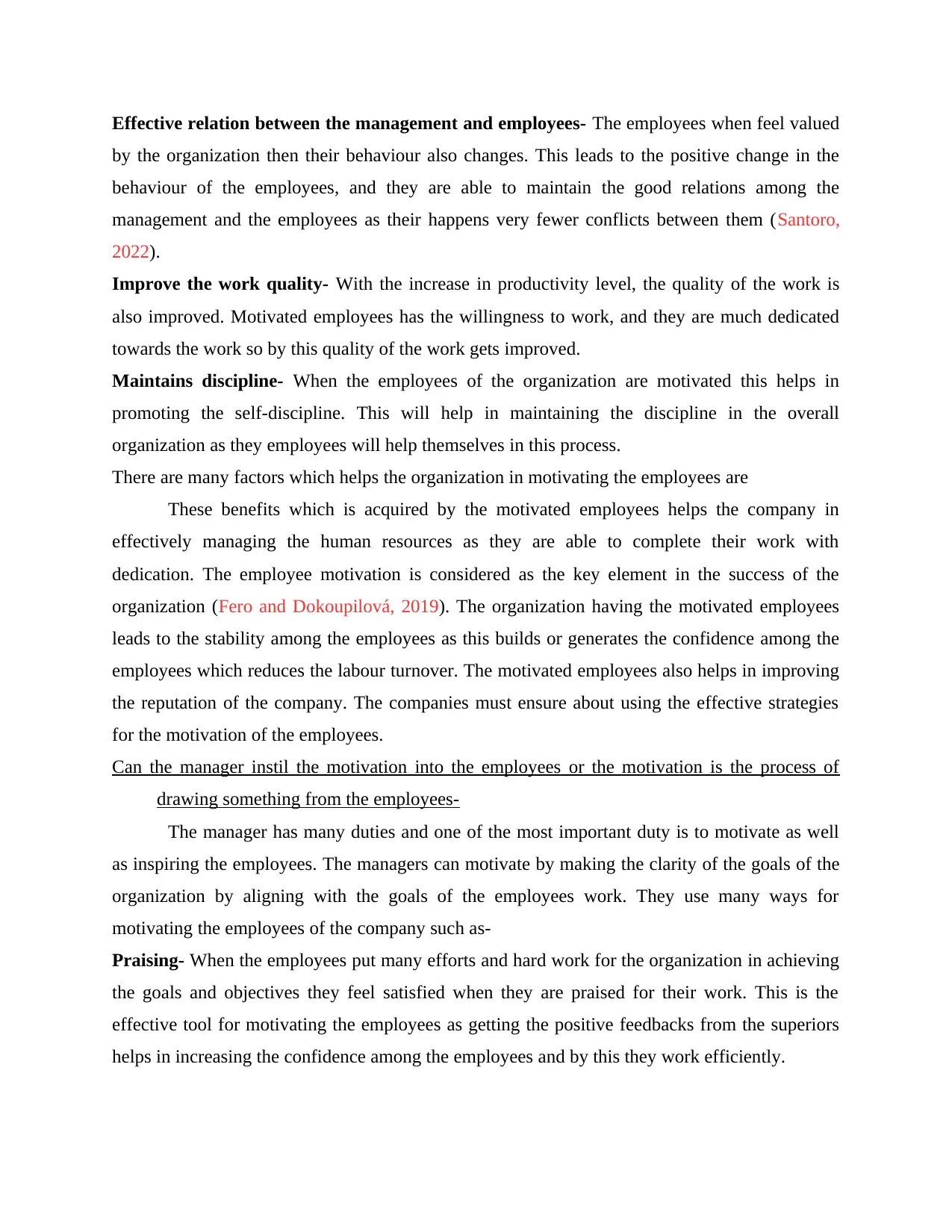
Effective relation between the management and employees- The employees when feel valued
by the organization then their behaviour also changes. This leads to the positive change in the
behaviour of the employees, and they are able to maintain the good relations among the
management and the employees as their happens very fewer conflicts between them (Santoro,
2022).
Improve the work quality- With the increase in productivity level, the quality of the work is
also improved. Motivated employees has the willingness to work, and they are much dedicated
towards the work so by this quality of the work gets improved.
Maintains discipline- When the employees of the organization are motivated this helps in
promoting the self-discipline. This will help in maintaining the discipline in the overall
organization as they employees will help themselves in this process.
There are many factors which helps the organization in motivating the employees are
These benefits which is acquired by the motivated employees helps the company in
effectively managing the human resources as they are able to complete their work with
dedication. The employee motivation is considered as the key element in the success of the
organization (Fero and Dokoupilová, 2019). The organization having the motivated employees
leads to the stability among the employees as this builds or generates the confidence among the
employees which reduces the labour turnover. The motivated employees also helps in improving
the reputation of the company. The companies must ensure about using the effective strategies
for the motivation of the employees.
Can the manager instil the motivation into the employees or the motivation is the process of
drawing something from the employees-
The manager has many duties and one of the most important duty is to motivate as well
as inspiring the employees. The managers can motivate by making the clarity of the goals of the
organization by aligning with the goals of the employees work. They use many ways for
motivating the employees of the company such as-
Praising- When the employees put many efforts and hard work for the organization in achieving
the goals and objectives they feel satisfied when they are praised for their work. This is the
effective tool for motivating the employees as getting the positive feedbacks from the superiors
helps in increasing the confidence among the employees and by this they work efficiently.
by the organization then their behaviour also changes. This leads to the positive change in the
behaviour of the employees, and they are able to maintain the good relations among the
management and the employees as their happens very fewer conflicts between them (Santoro,
2022).
Improve the work quality- With the increase in productivity level, the quality of the work is
also improved. Motivated employees has the willingness to work, and they are much dedicated
towards the work so by this quality of the work gets improved.
Maintains discipline- When the employees of the organization are motivated this helps in
promoting the self-discipline. This will help in maintaining the discipline in the overall
organization as they employees will help themselves in this process.
There are many factors which helps the organization in motivating the employees are
These benefits which is acquired by the motivated employees helps the company in
effectively managing the human resources as they are able to complete their work with
dedication. The employee motivation is considered as the key element in the success of the
organization (Fero and Dokoupilová, 2019). The organization having the motivated employees
leads to the stability among the employees as this builds or generates the confidence among the
employees which reduces the labour turnover. The motivated employees also helps in improving
the reputation of the company. The companies must ensure about using the effective strategies
for the motivation of the employees.
Can the manager instil the motivation into the employees or the motivation is the process of
drawing something from the employees-
The manager has many duties and one of the most important duty is to motivate as well
as inspiring the employees. The managers can motivate by making the clarity of the goals of the
organization by aligning with the goals of the employees work. They use many ways for
motivating the employees of the company such as-
Praising- When the employees put many efforts and hard work for the organization in achieving
the goals and objectives they feel satisfied when they are praised for their work. This is the
effective tool for motivating the employees as getting the positive feedbacks from the superiors
helps in increasing the confidence among the employees and by this they work efficiently.
Secure Best Marks with AI Grader
Need help grading? Try our AI Grader for instant feedback on your assignments.
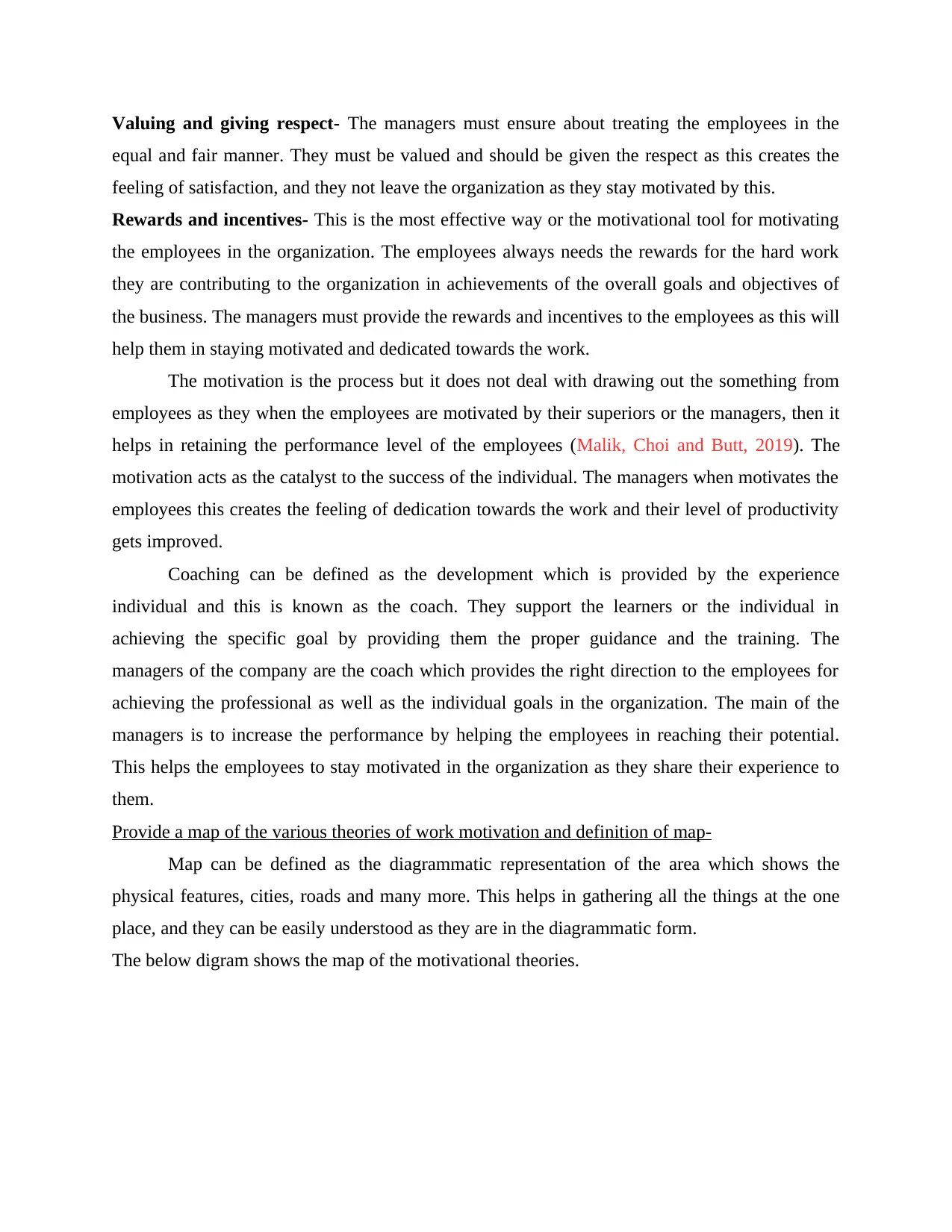
Valuing and giving respect- The managers must ensure about treating the employees in the
equal and fair manner. They must be valued and should be given the respect as this creates the
feeling of satisfaction, and they not leave the organization as they stay motivated by this.
Rewards and incentives- This is the most effective way or the motivational tool for motivating
the employees in the organization. The employees always needs the rewards for the hard work
they are contributing to the organization in achievements of the overall goals and objectives of
the business. The managers must provide the rewards and incentives to the employees as this will
help them in staying motivated and dedicated towards the work.
The motivation is the process but it does not deal with drawing out the something from
employees as they when the employees are motivated by their superiors or the managers, then it
helps in retaining the performance level of the employees (Malik, Choi and Butt, 2019). The
motivation acts as the catalyst to the success of the individual. The managers when motivates the
employees this creates the feeling of dedication towards the work and their level of productivity
gets improved.
Coaching can be defined as the development which is provided by the experience
individual and this is known as the coach. They support the learners or the individual in
achieving the specific goal by providing them the proper guidance and the training. The
managers of the company are the coach which provides the right direction to the employees for
achieving the professional as well as the individual goals in the organization. The main of the
managers is to increase the performance by helping the employees in reaching their potential.
This helps the employees to stay motivated in the organization as they share their experience to
them.
Provide a map of the various theories of work motivation and definition of map-
Map can be defined as the diagrammatic representation of the area which shows the
physical features, cities, roads and many more. This helps in gathering all the things at the one
place, and they can be easily understood as they are in the diagrammatic form.
The below digram shows the map of the motivational theories.
equal and fair manner. They must be valued and should be given the respect as this creates the
feeling of satisfaction, and they not leave the organization as they stay motivated by this.
Rewards and incentives- This is the most effective way or the motivational tool for motivating
the employees in the organization. The employees always needs the rewards for the hard work
they are contributing to the organization in achievements of the overall goals and objectives of
the business. The managers must provide the rewards and incentives to the employees as this will
help them in staying motivated and dedicated towards the work.
The motivation is the process but it does not deal with drawing out the something from
employees as they when the employees are motivated by their superiors or the managers, then it
helps in retaining the performance level of the employees (Malik, Choi and Butt, 2019). The
motivation acts as the catalyst to the success of the individual. The managers when motivates the
employees this creates the feeling of dedication towards the work and their level of productivity
gets improved.
Coaching can be defined as the development which is provided by the experience
individual and this is known as the coach. They support the learners or the individual in
achieving the specific goal by providing them the proper guidance and the training. The
managers of the company are the coach which provides the right direction to the employees for
achieving the professional as well as the individual goals in the organization. The main of the
managers is to increase the performance by helping the employees in reaching their potential.
This helps the employees to stay motivated in the organization as they share their experience to
them.
Provide a map of the various theories of work motivation and definition of map-
Map can be defined as the diagrammatic representation of the area which shows the
physical features, cities, roads and many more. This helps in gathering all the things at the one
place, and they can be easily understood as they are in the diagrammatic form.
The below digram shows the map of the motivational theories.
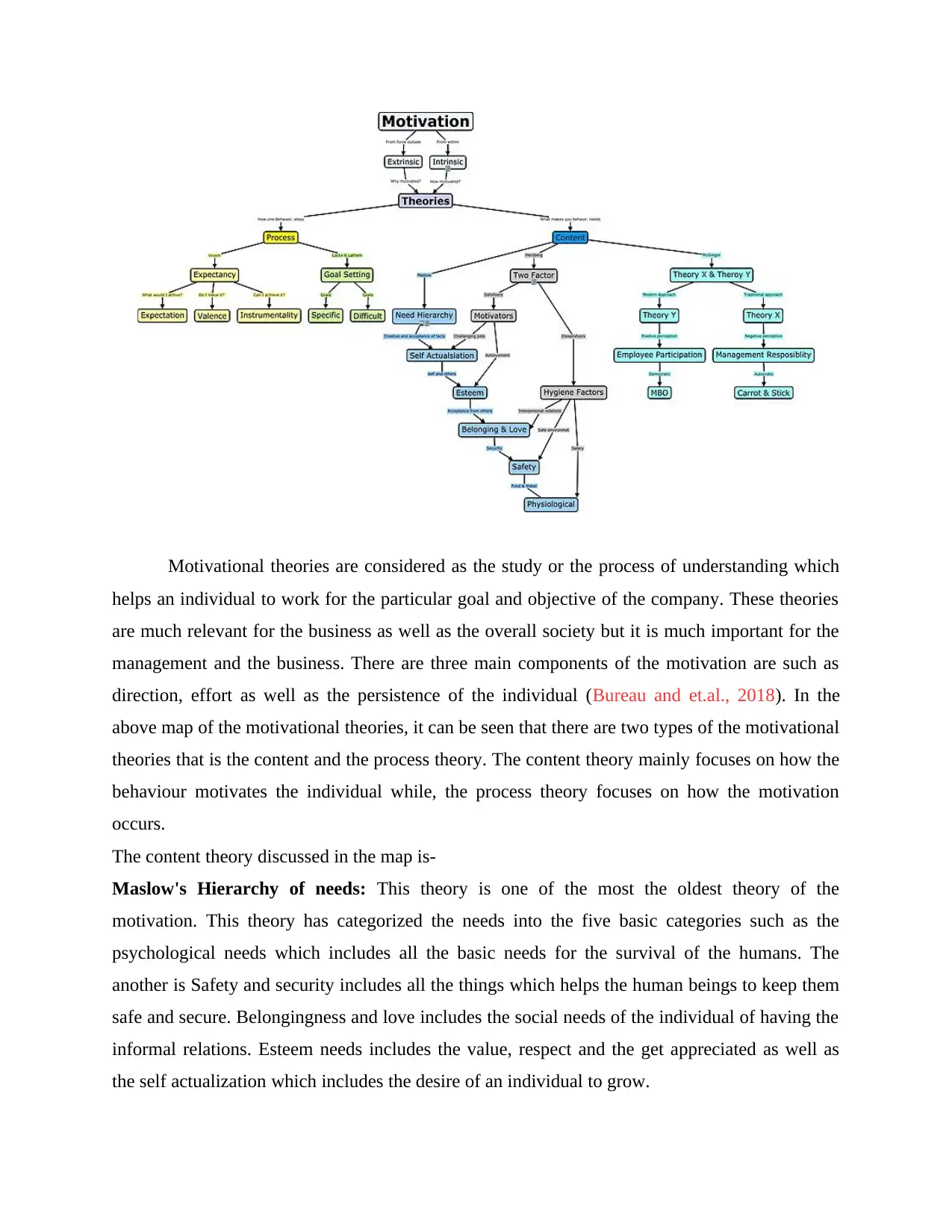
Motivational theories are considered as the study or the process of understanding which
helps an individual to work for the particular goal and objective of the company. These theories
are much relevant for the business as well as the overall society but it is much important for the
management and the business. There are three main components of the motivation are such as
direction, effort as well as the persistence of the individual (Bureau and et.al., 2018). In the
above map of the motivational theories, it can be seen that there are two types of the motivational
theories that is the content and the process theory. The content theory mainly focuses on how the
behaviour motivates the individual while, the process theory focuses on how the motivation
occurs.
The content theory discussed in the map is-
Maslow's Hierarchy of needs: This theory is one of the most the oldest theory of the
motivation. This theory has categorized the needs into the five basic categories such as the
psychological needs which includes all the basic needs for the survival of the humans. The
another is Safety and security includes all the things which helps the human beings to keep them
safe and secure. Belongingness and love includes the social needs of the individual of having the
informal relations. Esteem needs includes the value, respect and the get appreciated as well as
the self actualization which includes the desire of an individual to grow.
helps an individual to work for the particular goal and objective of the company. These theories
are much relevant for the business as well as the overall society but it is much important for the
management and the business. There are three main components of the motivation are such as
direction, effort as well as the persistence of the individual (Bureau and et.al., 2018). In the
above map of the motivational theories, it can be seen that there are two types of the motivational
theories that is the content and the process theory. The content theory mainly focuses on how the
behaviour motivates the individual while, the process theory focuses on how the motivation
occurs.
The content theory discussed in the map is-
Maslow's Hierarchy of needs: This theory is one of the most the oldest theory of the
motivation. This theory has categorized the needs into the five basic categories such as the
psychological needs which includes all the basic needs for the survival of the humans. The
another is Safety and security includes all the things which helps the human beings to keep them
safe and secure. Belongingness and love includes the social needs of the individual of having the
informal relations. Esteem needs includes the value, respect and the get appreciated as well as
the self actualization which includes the desire of an individual to grow.
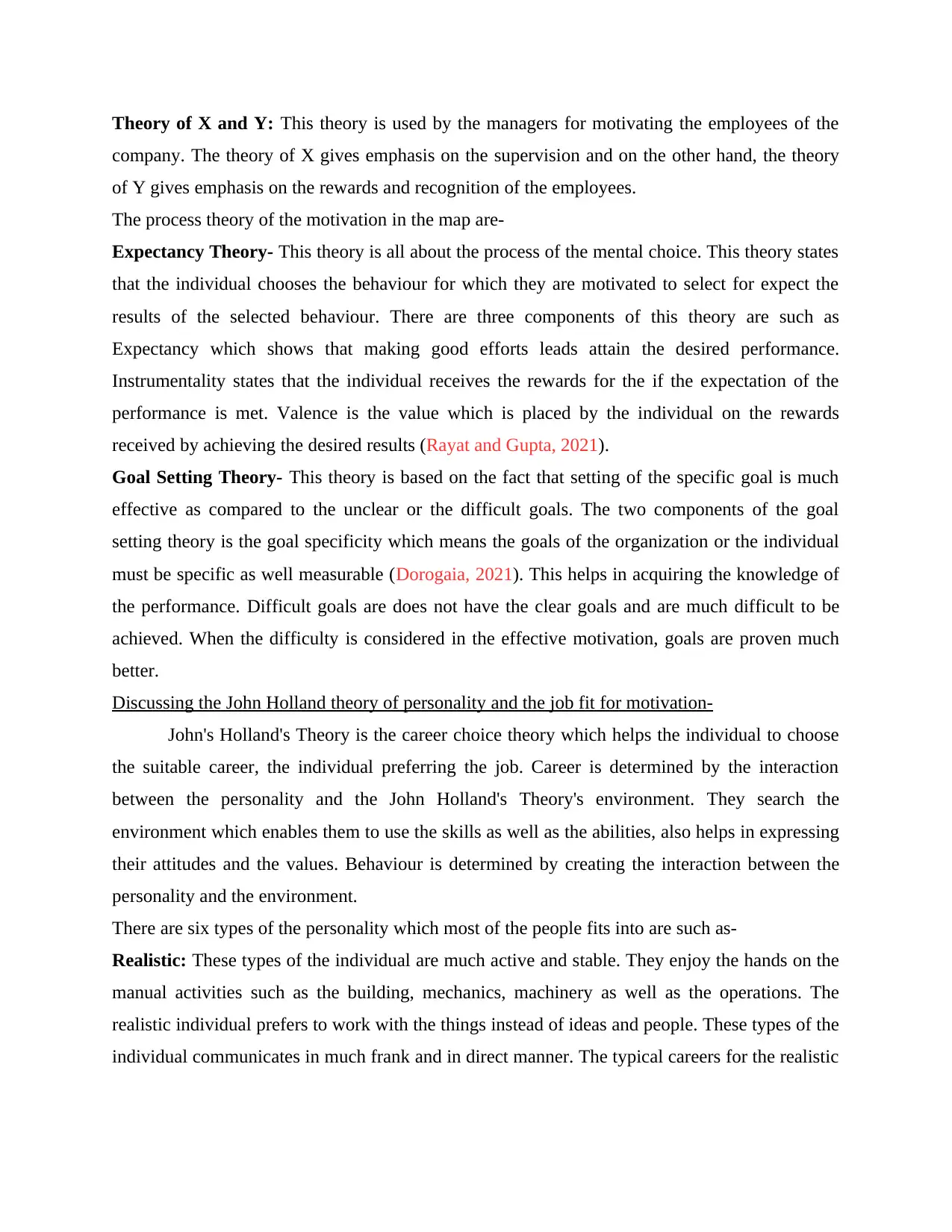
Theory of X and Y: This theory is used by the managers for motivating the employees of the
company. The theory of X gives emphasis on the supervision and on the other hand, the theory
of Y gives emphasis on the rewards and recognition of the employees.
The process theory of the motivation in the map are-
Expectancy Theory- This theory is all about the process of the mental choice. This theory states
that the individual chooses the behaviour for which they are motivated to select for expect the
results of the selected behaviour. There are three components of this theory are such as
Expectancy which shows that making good efforts leads attain the desired performance.
Instrumentality states that the individual receives the rewards for the if the expectation of the
performance is met. Valence is the value which is placed by the individual on the rewards
received by achieving the desired results (Rayat and Gupta, 2021).
Goal Setting Theory- This theory is based on the fact that setting of the specific goal is much
effective as compared to the unclear or the difficult goals. The two components of the goal
setting theory is the goal specificity which means the goals of the organization or the individual
must be specific as well measurable (Dorogaia, 2021). This helps in acquiring the knowledge of
the performance. Difficult goals are does not have the clear goals and are much difficult to be
achieved. When the difficulty is considered in the effective motivation, goals are proven much
better.
Discussing the John Holland theory of personality and the job fit for motivation-
John's Holland's Theory is the career choice theory which helps the individual to choose
the suitable career, the individual preferring the job. Career is determined by the interaction
between the personality and the John Holland's Theory's environment. They search the
environment which enables them to use the skills as well as the abilities, also helps in expressing
their attitudes and the values. Behaviour is determined by creating the interaction between the
personality and the environment.
There are six types of the personality which most of the people fits into are such as-
Realistic: These types of the individual are much active and stable. They enjoy the hands on the
manual activities such as the building, mechanics, machinery as well as the operations. The
realistic individual prefers to work with the things instead of ideas and people. These types of the
individual communicates in much frank and in direct manner. The typical careers for the realistic
company. The theory of X gives emphasis on the supervision and on the other hand, the theory
of Y gives emphasis on the rewards and recognition of the employees.
The process theory of the motivation in the map are-
Expectancy Theory- This theory is all about the process of the mental choice. This theory states
that the individual chooses the behaviour for which they are motivated to select for expect the
results of the selected behaviour. There are three components of this theory are such as
Expectancy which shows that making good efforts leads attain the desired performance.
Instrumentality states that the individual receives the rewards for the if the expectation of the
performance is met. Valence is the value which is placed by the individual on the rewards
received by achieving the desired results (Rayat and Gupta, 2021).
Goal Setting Theory- This theory is based on the fact that setting of the specific goal is much
effective as compared to the unclear or the difficult goals. The two components of the goal
setting theory is the goal specificity which means the goals of the organization or the individual
must be specific as well measurable (Dorogaia, 2021). This helps in acquiring the knowledge of
the performance. Difficult goals are does not have the clear goals and are much difficult to be
achieved. When the difficulty is considered in the effective motivation, goals are proven much
better.
Discussing the John Holland theory of personality and the job fit for motivation-
John's Holland's Theory is the career choice theory which helps the individual to choose
the suitable career, the individual preferring the job. Career is determined by the interaction
between the personality and the John Holland's Theory's environment. They search the
environment which enables them to use the skills as well as the abilities, also helps in expressing
their attitudes and the values. Behaviour is determined by creating the interaction between the
personality and the environment.
There are six types of the personality which most of the people fits into are such as-
Realistic: These types of the individual are much active and stable. They enjoy the hands on the
manual activities such as the building, mechanics, machinery as well as the operations. The
realistic individual prefers to work with the things instead of ideas and people. These types of the
individual communicates in much frank and in direct manner. The typical careers for the realistic
Paraphrase This Document
Need a fresh take? Get an instant paraphrase of this document with our AI Paraphraser
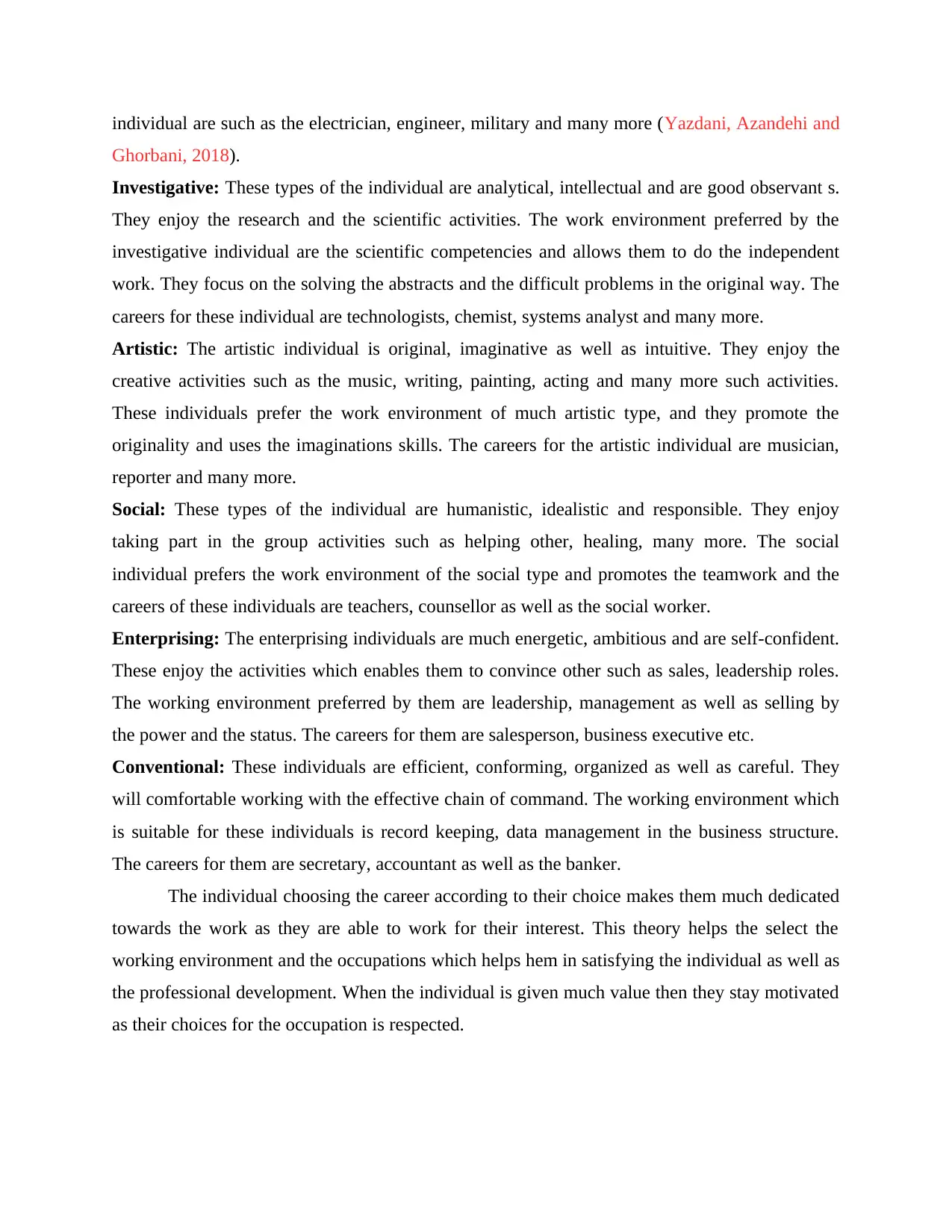
individual are such as the electrician, engineer, military and many more (Yazdani, Azandehi and
Ghorbani, 2018).
Investigative: These types of the individual are analytical, intellectual and are good observant s.
They enjoy the research and the scientific activities. The work environment preferred by the
investigative individual are the scientific competencies and allows them to do the independent
work. They focus on the solving the abstracts and the difficult problems in the original way. The
careers for these individual are technologists, chemist, systems analyst and many more.
Artistic: The artistic individual is original, imaginative as well as intuitive. They enjoy the
creative activities such as the music, writing, painting, acting and many more such activities.
These individuals prefer the work environment of much artistic type, and they promote the
originality and uses the imaginations skills. The careers for the artistic individual are musician,
reporter and many more.
Social: These types of the individual are humanistic, idealistic and responsible. They enjoy
taking part in the group activities such as helping other, healing, many more. The social
individual prefers the work environment of the social type and promotes the teamwork and the
careers of these individuals are teachers, counsellor as well as the social worker.
Enterprising: The enterprising individuals are much energetic, ambitious and are self-confident.
These enjoy the activities which enables them to convince other such as sales, leadership roles.
The working environment preferred by them are leadership, management as well as selling by
the power and the status. The careers for them are salesperson, business executive etc.
Conventional: These individuals are efficient, conforming, organized as well as careful. They
will comfortable working with the effective chain of command. The working environment which
is suitable for these individuals is record keeping, data management in the business structure.
The careers for them are secretary, accountant as well as the banker.
The individual choosing the career according to their choice makes them much dedicated
towards the work as they are able to work for their interest. This theory helps the select the
working environment and the occupations which helps hem in satisfying the individual as well as
the professional development. When the individual is given much value then they stay motivated
as their choices for the occupation is respected.
Ghorbani, 2018).
Investigative: These types of the individual are analytical, intellectual and are good observant s.
They enjoy the research and the scientific activities. The work environment preferred by the
investigative individual are the scientific competencies and allows them to do the independent
work. They focus on the solving the abstracts and the difficult problems in the original way. The
careers for these individual are technologists, chemist, systems analyst and many more.
Artistic: The artistic individual is original, imaginative as well as intuitive. They enjoy the
creative activities such as the music, writing, painting, acting and many more such activities.
These individuals prefer the work environment of much artistic type, and they promote the
originality and uses the imaginations skills. The careers for the artistic individual are musician,
reporter and many more.
Social: These types of the individual are humanistic, idealistic and responsible. They enjoy
taking part in the group activities such as helping other, healing, many more. The social
individual prefers the work environment of the social type and promotes the teamwork and the
careers of these individuals are teachers, counsellor as well as the social worker.
Enterprising: The enterprising individuals are much energetic, ambitious and are self-confident.
These enjoy the activities which enables them to convince other such as sales, leadership roles.
The working environment preferred by them are leadership, management as well as selling by
the power and the status. The careers for them are salesperson, business executive etc.
Conventional: These individuals are efficient, conforming, organized as well as careful. They
will comfortable working with the effective chain of command. The working environment which
is suitable for these individuals is record keeping, data management in the business structure.
The careers for them are secretary, accountant as well as the banker.
The individual choosing the career according to their choice makes them much dedicated
towards the work as they are able to work for their interest. This theory helps the select the
working environment and the occupations which helps hem in satisfying the individual as well as
the professional development. When the individual is given much value then they stay motivated
as their choices for the occupation is respected.
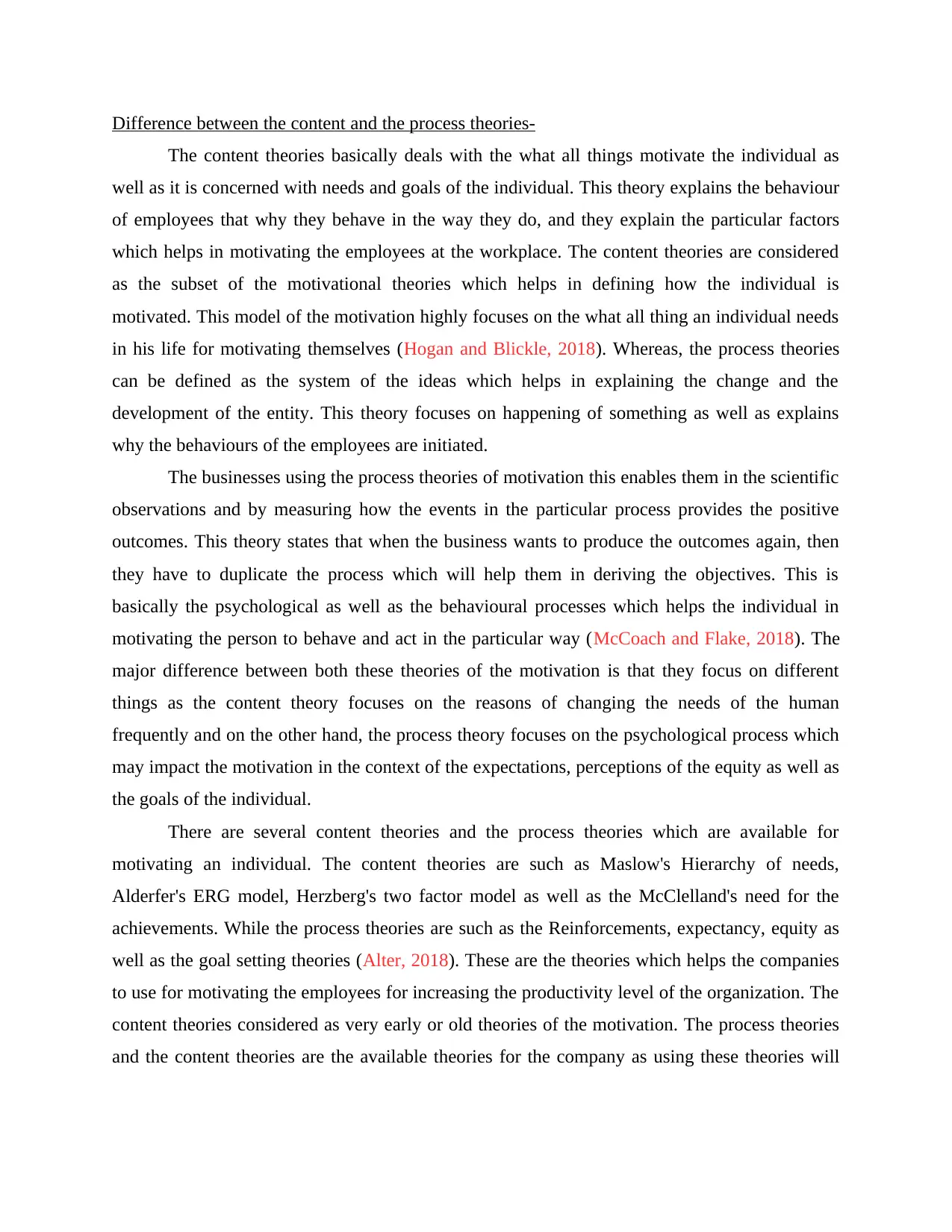
Difference between the content and the process theories-
The content theories basically deals with the what all things motivate the individual as
well as it is concerned with needs and goals of the individual. This theory explains the behaviour
of employees that why they behave in the way they do, and they explain the particular factors
which helps in motivating the employees at the workplace. The content theories are considered
as the subset of the motivational theories which helps in defining how the individual is
motivated. This model of the motivation highly focuses on the what all thing an individual needs
in his life for motivating themselves (Hogan and Blickle, 2018). Whereas, the process theories
can be defined as the system of the ideas which helps in explaining the change and the
development of the entity. This theory focuses on happening of something as well as explains
why the behaviours of the employees are initiated.
The businesses using the process theories of motivation this enables them in the scientific
observations and by measuring how the events in the particular process provides the positive
outcomes. This theory states that when the business wants to produce the outcomes again, then
they have to duplicate the process which will help them in deriving the objectives. This is
basically the psychological as well as the behavioural processes which helps the individual in
motivating the person to behave and act in the particular way (McCoach and Flake, 2018). The
major difference between both these theories of the motivation is that they focus on different
things as the content theory focuses on the reasons of changing the needs of the human
frequently and on the other hand, the process theory focuses on the psychological process which
may impact the motivation in the context of the expectations, perceptions of the equity as well as
the goals of the individual.
There are several content theories and the process theories which are available for
motivating an individual. The content theories are such as Maslow's Hierarchy of needs,
Alderfer's ERG model, Herzberg's two factor model as well as the McClelland's need for the
achievements. While the process theories are such as the Reinforcements, expectancy, equity as
well as the goal setting theories (Alter, 2018). These are the theories which helps the companies
to use for motivating the employees for increasing the productivity level of the organization. The
content theories considered as very early or old theories of the motivation. The process theories
and the content theories are the available theories for the company as using these theories will
The content theories basically deals with the what all things motivate the individual as
well as it is concerned with needs and goals of the individual. This theory explains the behaviour
of employees that why they behave in the way they do, and they explain the particular factors
which helps in motivating the employees at the workplace. The content theories are considered
as the subset of the motivational theories which helps in defining how the individual is
motivated. This model of the motivation highly focuses on the what all thing an individual needs
in his life for motivating themselves (Hogan and Blickle, 2018). Whereas, the process theories
can be defined as the system of the ideas which helps in explaining the change and the
development of the entity. This theory focuses on happening of something as well as explains
why the behaviours of the employees are initiated.
The businesses using the process theories of motivation this enables them in the scientific
observations and by measuring how the events in the particular process provides the positive
outcomes. This theory states that when the business wants to produce the outcomes again, then
they have to duplicate the process which will help them in deriving the objectives. This is
basically the psychological as well as the behavioural processes which helps the individual in
motivating the person to behave and act in the particular way (McCoach and Flake, 2018). The
major difference between both these theories of the motivation is that they focus on different
things as the content theory focuses on the reasons of changing the needs of the human
frequently and on the other hand, the process theory focuses on the psychological process which
may impact the motivation in the context of the expectations, perceptions of the equity as well as
the goals of the individual.
There are several content theories and the process theories which are available for
motivating an individual. The content theories are such as Maslow's Hierarchy of needs,
Alderfer's ERG model, Herzberg's two factor model as well as the McClelland's need for the
achievements. While the process theories are such as the Reinforcements, expectancy, equity as
well as the goal setting theories (Alter, 2018). These are the theories which helps the companies
to use for motivating the employees for increasing the productivity level of the organization. The
content theories considered as very early or old theories of the motivation. The process theories
and the content theories are the available theories for the company as using these theories will
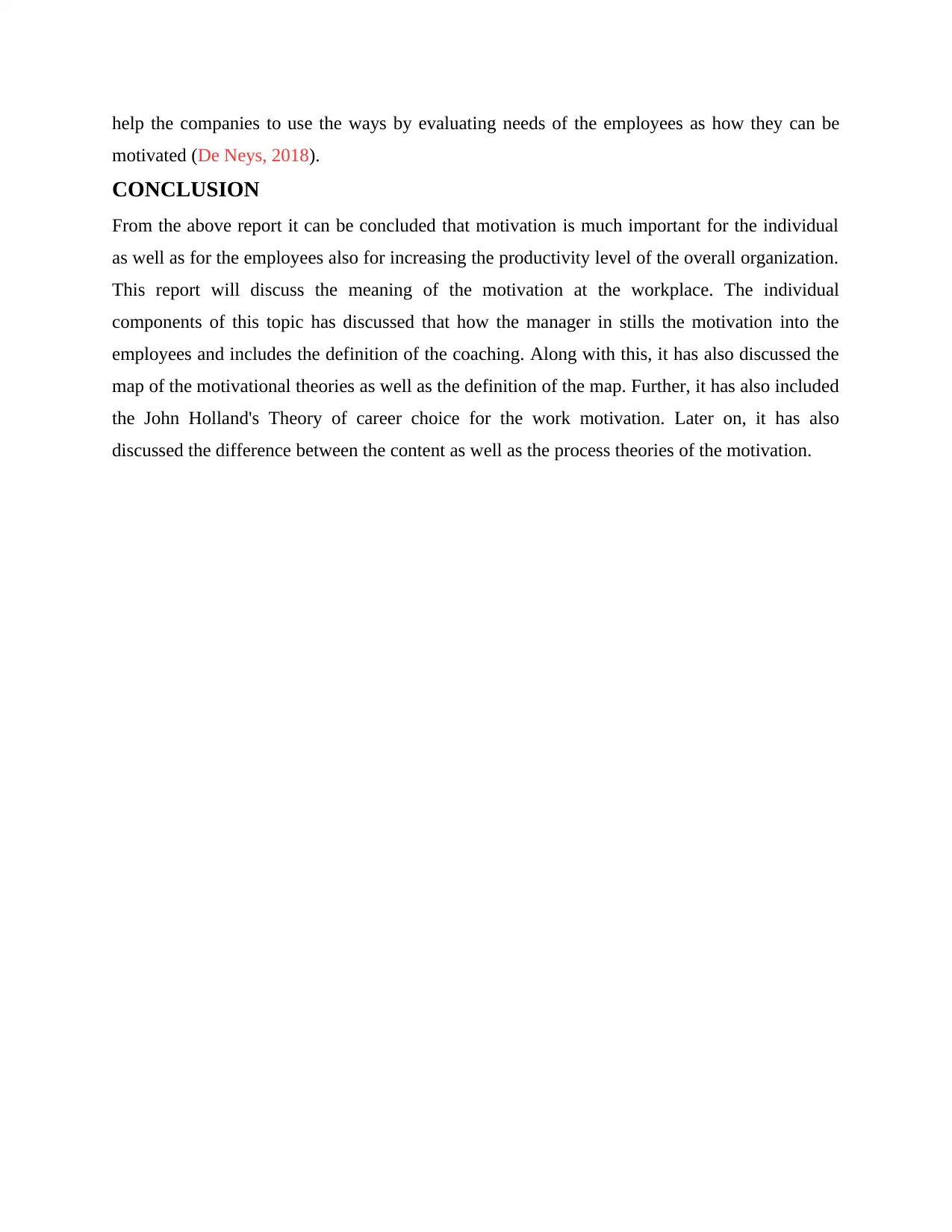
help the companies to use the ways by evaluating needs of the employees as how they can be
motivated (De Neys, 2018).
CONCLUSION
From the above report it can be concluded that motivation is much important for the individual
as well as for the employees also for increasing the productivity level of the overall organization.
This report will discuss the meaning of the motivation at the workplace. The individual
components of this topic has discussed that how the manager in stills the motivation into the
employees and includes the definition of the coaching. Along with this, it has also discussed the
map of the motivational theories as well as the definition of the map. Further, it has also included
the John Holland's Theory of career choice for the work motivation. Later on, it has also
discussed the difference between the content as well as the process theories of the motivation.
motivated (De Neys, 2018).
CONCLUSION
From the above report it can be concluded that motivation is much important for the individual
as well as for the employees also for increasing the productivity level of the overall organization.
This report will discuss the meaning of the motivation at the workplace. The individual
components of this topic has discussed that how the manager in stills the motivation into the
employees and includes the definition of the coaching. Along with this, it has also discussed the
map of the motivational theories as well as the definition of the map. Further, it has also included
the John Holland's Theory of career choice for the work motivation. Later on, it has also
discussed the difference between the content as well as the process theories of the motivation.
Secure Best Marks with AI Grader
Need help grading? Try our AI Grader for instant feedback on your assignments.
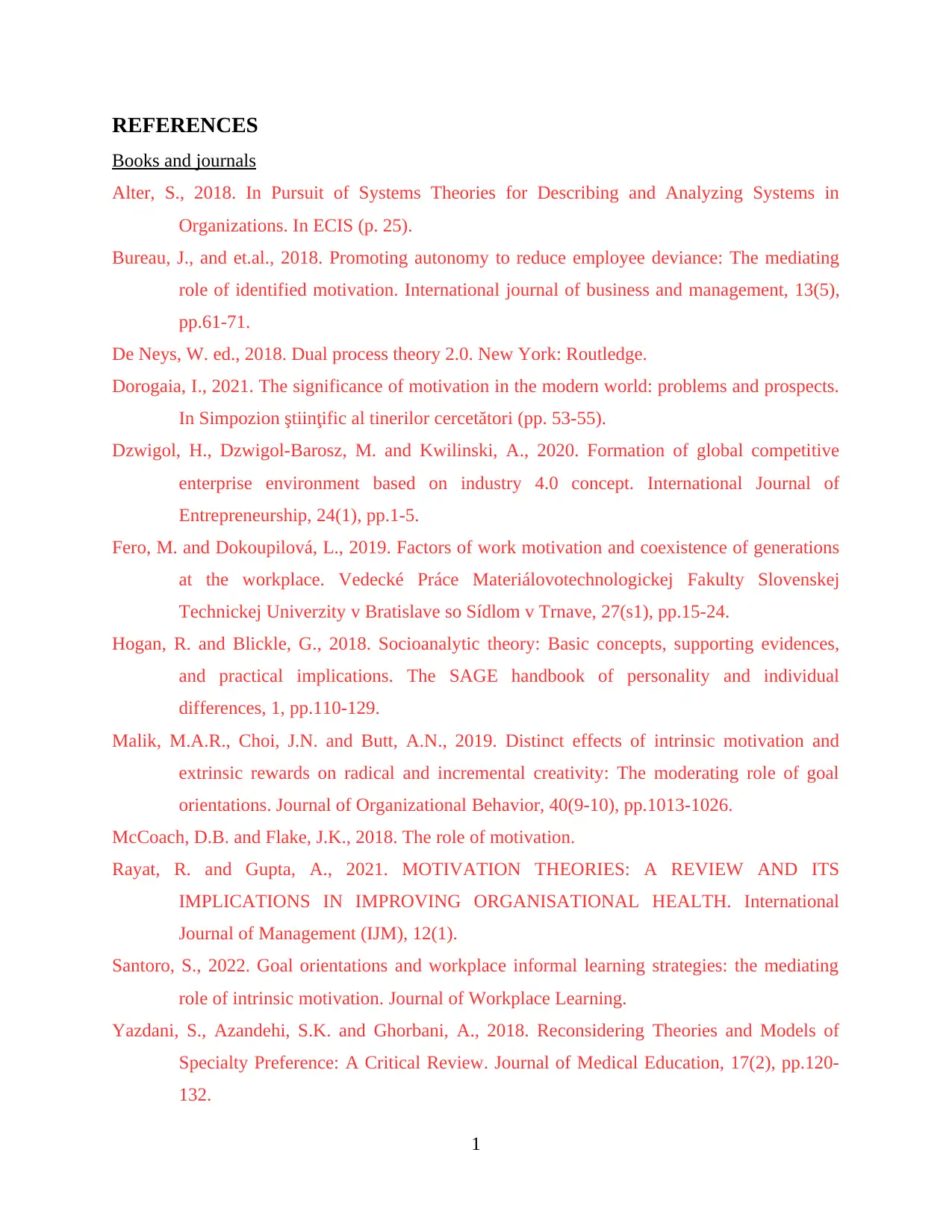
REFERENCES
Books and journals
Alter, S., 2018. In Pursuit of Systems Theories for Describing and Analyzing Systems in
Organizations. In ECIS (p. 25).
Bureau, J., and et.al., 2018. Promoting autonomy to reduce employee deviance: The mediating
role of identified motivation. International journal of business and management, 13(5),
pp.61-71.
De Neys, W. ed., 2018. Dual process theory 2.0. New York: Routledge.
Dorogaia, I., 2021. The significance of motivation in the modern world: problems and prospects.
In Simpozion ştiinţific al tinerilor cercetători (pp. 53-55).
Dzwigol, H., Dzwigol-Barosz, M. and Kwilinski, A., 2020. Formation of global competitive
enterprise environment based on industry 4.0 concept. International Journal of
Entrepreneurship, 24(1), pp.1-5.
Fero, M. and Dokoupilová, L., 2019. Factors of work motivation and coexistence of generations
at the workplace. Vedecké Práce Materiálovotechnologickej Fakulty Slovenskej
Technickej Univerzity v Bratislave so Sídlom v Trnave, 27(s1), pp.15-24.
Hogan, R. and Blickle, G., 2018. Socioanalytic theory: Basic concepts, supporting evidences,
and practical implications. The SAGE handbook of personality and individual
differences, 1, pp.110-129.
Malik, M.A.R., Choi, J.N. and Butt, A.N., 2019. Distinct effects of intrinsic motivation and
extrinsic rewards on radical and incremental creativity: The moderating role of goal
orientations. Journal of Organizational Behavior, 40(9-10), pp.1013-1026.
McCoach, D.B. and Flake, J.K., 2018. The role of motivation.
Rayat, R. and Gupta, A., 2021. MOTIVATION THEORIES: A REVIEW AND ITS
IMPLICATIONS IN IMPROVING ORGANISATIONAL HEALTH. International
Journal of Management (IJM), 12(1).
Santoro, S., 2022. Goal orientations and workplace informal learning strategies: the mediating
role of intrinsic motivation. Journal of Workplace Learning.
Yazdani, S., Azandehi, S.K. and Ghorbani, A., 2018. Reconsidering Theories and Models of
Specialty Preference: A Critical Review. Journal of Medical Education, 17(2), pp.120-
132.
1
Books and journals
Alter, S., 2018. In Pursuit of Systems Theories for Describing and Analyzing Systems in
Organizations. In ECIS (p. 25).
Bureau, J., and et.al., 2018. Promoting autonomy to reduce employee deviance: The mediating
role of identified motivation. International journal of business and management, 13(5),
pp.61-71.
De Neys, W. ed., 2018. Dual process theory 2.0. New York: Routledge.
Dorogaia, I., 2021. The significance of motivation in the modern world: problems and prospects.
In Simpozion ştiinţific al tinerilor cercetători (pp. 53-55).
Dzwigol, H., Dzwigol-Barosz, M. and Kwilinski, A., 2020. Formation of global competitive
enterprise environment based on industry 4.0 concept. International Journal of
Entrepreneurship, 24(1), pp.1-5.
Fero, M. and Dokoupilová, L., 2019. Factors of work motivation and coexistence of generations
at the workplace. Vedecké Práce Materiálovotechnologickej Fakulty Slovenskej
Technickej Univerzity v Bratislave so Sídlom v Trnave, 27(s1), pp.15-24.
Hogan, R. and Blickle, G., 2018. Socioanalytic theory: Basic concepts, supporting evidences,
and practical implications. The SAGE handbook of personality and individual
differences, 1, pp.110-129.
Malik, M.A.R., Choi, J.N. and Butt, A.N., 2019. Distinct effects of intrinsic motivation and
extrinsic rewards on radical and incremental creativity: The moderating role of goal
orientations. Journal of Organizational Behavior, 40(9-10), pp.1013-1026.
McCoach, D.B. and Flake, J.K., 2018. The role of motivation.
Rayat, R. and Gupta, A., 2021. MOTIVATION THEORIES: A REVIEW AND ITS
IMPLICATIONS IN IMPROVING ORGANISATIONAL HEALTH. International
Journal of Management (IJM), 12(1).
Santoro, S., 2022. Goal orientations and workplace informal learning strategies: the mediating
role of intrinsic motivation. Journal of Workplace Learning.
Yazdani, S., Azandehi, S.K. and Ghorbani, A., 2018. Reconsidering Theories and Models of
Specialty Preference: A Critical Review. Journal of Medical Education, 17(2), pp.120-
132.
1

2
1 out of 12
Related Documents
Your All-in-One AI-Powered Toolkit for Academic Success.
+13062052269
info@desklib.com
Available 24*7 on WhatsApp / Email
![[object Object]](/_next/static/media/star-bottom.7253800d.svg)
Unlock your academic potential
© 2024 | Zucol Services PVT LTD | All rights reserved.





